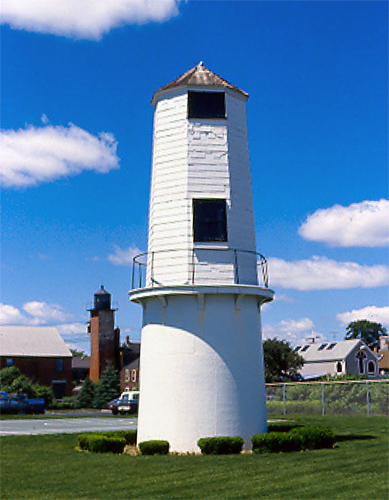In the small town of Newburyport, Massachusetts a once-in-a-lifetime experience awaits those who are willing to donate $350 to support lighthouse preservation efforts. With advance reservations, two to four persons may enjoy six hours of marvelous views from the lantern room of the Newburyport Harbor Rear Range Light along with fine dining catered by their choice of five local restaurants (food and drinks are extra). One should be aware that negotiating steep steps and a metal-rung ladder is required to reach the unique dining room.
|
Fires were routinely set on the beach at Plum Island to guide mariners to the mouth of the Merrimack River until the Marine Society of Newburyport erected two day beacons in 1783 and employed men to hoist lanterns atop them at night. The construction of two formal lighthouses on the island in 1788 proved even more beneficial for mariners wishing to enter the Merrimack River, but it was obvious that another set of range lights was needed to help mariners navigate roughly two miles up the river to reach the town.
Range lights, also known as leading lights, are typically a pair of lights displayed at different heights and located far enough apart to enable mariners to line one above the other to indicate the center of a channel. Normally, the front light is shorter than the back or rear light.
For several years a pair of range lights in Newburyport Harbor was maintained by private subscriptions. In 1871, the citizens of Newburyport petitioned the Government to take charge of these lights, and the following year negotiations were underway to obtain titles to the range light sites so that new towers could be erected. On June 10, 1872, Congress appropriated $10,000 “for re-establishing and setting up two small beacon lights in harbor of Newburyport, the site of one of which has been washed away by a storm.”
The construction of the present Newburyport Harbor Range Lights is detailed in Lighthouse Board records:
Two range lights to guide up the River Merrimack to the city of Newburyport have been established in the same position as the private lights before maintained by subscription, and were lighted June 1, 1873. The front light is an iron tower, conical in form, 14 feet 6 inches high, located on Bayley’s new wharf, and the focal plane is 25 feet above the sea. The rear light is about 350 feet W. ½ S. from the front light, on a brick tower, pyramidal in form, 32 feet high, and the focal plane is 47 feet above the sea.Local caretakers were initially responsible for the lights. The first keeper of the Newburyport Harbor Range Lights was George Stickney, who started at an annual salary of $250 and served until 1886. Keepers at the nearby Plum Island Lights later assumed responsibility for the harbor range lights.
In 1961, both range lights were decommissioned. Not long after, the Rear Range Light was sold to a private party, while the Front Range Light was relocated to the nearby Merrimack River Coast Guard Station. The Front Range Light suffered severe fire damage in the 1990s and has subsequently been restored to its original form with a replica lantern room placed on top of its base.
Newburyport is called the “Birthplace of the U.S. Coast Guard” by some, as the U.S. Revenue Cutter Massachusetts, the first cutter commissioned by the Federal Government, was built in Newburyport in 1791. The Revenue Cutter Service was merged with the Lifesaving Service in 1915 to form the U.S. Coast Guard, and the Lighthouse Service was brought under control of the Coast Guard in 1939.





No comments:
Post a Comment